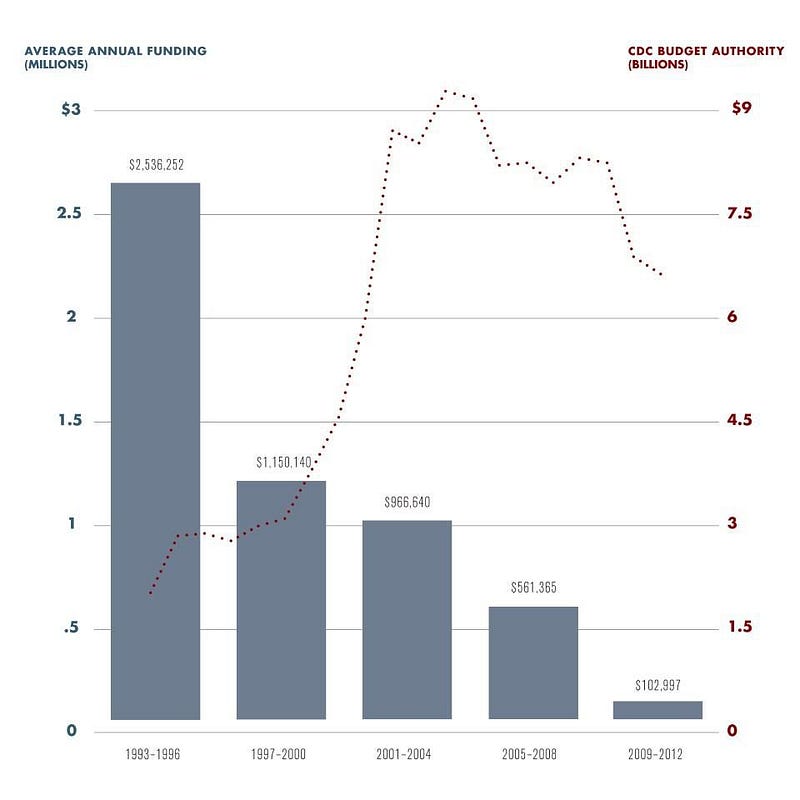Opioid Epidemic So Severe, Says CDC, It’s Finally Killing As Many Americans As Guns

In 2016, the number of opioid-related deaths hit 42,000, an all-time record. But gun deaths were nearly that same number, and have been consistently that high.
If you want to know what’s dangerous to Americans, the place to look is the CDC: the Centers for Disease Control. Studying all causes of death, disease, and preventative measures, they’re the most important health agency in the country. Their purview extends from yellow fever to influenza to suicide to addiction and binge drinking. If there’s a health problem plaguing this country, the CDC is the organization that studies it. You’ve likely heard a lot about the opioid epidemic recently, as there’s been a tremendous increase in the number of deaths related to heroin and other synthetic opioids, both with and without prescriptions, since 2010. With a record-setting 42,000+ drug overdose deaths involving an opioid in 2016, the death rate is now 5 times higher than it was in 1999. The problem is so bad, in fact, that opioids are finally killing as many Americans, on an annual basis, as firearms.

So why, then, are we calling the large number of deaths due to opioids an epidemic, while the equal number of deaths due to gun violence doesn’t receive the same designation? I reached out to the CDC to ask them, and was informed of the following:
Epidemic refers to an increase, often sudden, in the number of cases of a disease above what is normally expected in that population in that area.
In other words, we call the deaths due to opioids an epidemic because we had a baseline expectation of how many deaths, for a given population, we could expect in that arena. As the number of per-capita deaths has risen substantially, this signals an epidemic, because we’re seeing more opioid-related deaths than we’d previously expected. According to the CDC’s research itself, this pans out across-the-board.

But the number of deaths due to guns is just as bad as the opioid epidemic is now. Only, in the case of firearm-related deaths, it’s been consistently this high for many years. According to Courtney N. Lenard from the CDC’s Health Communication and Science Office,
Firearm-related injuries are among the 5 leading causes of death for people ages 1–64 in the United States. In 2016, an average of 106 people in the U.S. died each day as a result of firearm-related injuries (including homicides, suicides, unintentional firearm deaths, legal intervention, and firearm deaths of undetermined intent). […] The rates have been consistently high over time.
In other words, the only reason we don’t call firearm-related deaths an epidemic is because even though an equal number of people die from firearms, this rate has been consistent over time. Using data provided by the CDC, I was able to demonstrate this for myself.

As of 2016, the most recent year for which data is available, there were 38,658 gun-related deaths in the United States. Based on our population, that means 1-in-every-8,359 Americans was killed by a gun in 2016. This number, while slightly higher than previous years, doesn’t represent a large enough increase over the baseline expectation to warrant any special designation by the CDC. On the other hand, 2016 saw 32,445 American fatalities where a prescription opioid was involved, an increase of nearly 10,000 from the year before. However, whereas gun fatalities are indisputably due to the gun itself, ascribing deaths to opioids is trickier. Again, this is according to the CDC itself:
In approximately 1 in 5 drug overdose deaths, no specific drug is listed on the death certificate. In many deaths, multiple drugs are present, and it is difficult to identify which drug or drugs caused the death (for example, heroin or a prescription opioid, when both are present).

The reason we have an opioid epidemic is because the number of deaths where an opioid was involved has risen sharply over the past few years, signaling a change in the problem. The reason we don’t have a gun fatality epidemic is because rates, there, have been consistently high across all demographics: gun-related deaths are a hyperendemic problem. If we include all deaths where an opioid was found in the deceased’s system, both prescription and non-prescription, the 2016 death total exceeds 42,000, finally surpassing gun-related deaths.
However, unlike guns, opioid-related deaths are on the increase only in specific states, with the largest number of per-capita deaths in 2016 occurring in West Virginia (52.0 per 100,000), Ohio (39.1), New Hampshire (39.0), Pennsylvania (37.9) and (Kentucky (33.5).

When it comes to guns, however, both the death rate and the injury rate (which is slightly over twice the fatality rate, at approximately 84,000 total gun injuries per year) are consistent across both age ranges and geographic locations. While much of the recent public outcry over gun violence has focused on the school shooting at Marjory Stoneman Douglas High School, the fact is that even with 17 children killed and another 17 injured, that incident failed to make a significant impact on the total number of gun-related fatalities or injuries affecting children through just the first 50 days of 2018. School shootings are an insignificant (but high-profile) fraction of firearm-related deaths involving children. At the present rate, approximately 1400 deaths and 3000 injuries will befall Americans aged 0–17, due to guns, this year alone.

The Centers for Disease Control is not, as is commonly asserted, banned from studying gun violence or its effects on society or public health and safety. However, there are restrictions on it, primarily due to the 1996 Dickey Amendment. In particular, the language states:
That none of the funds made available for injury prevention and control at the Centers for Disease Control and Prevention may be used to advocate or promote gun control,
which means that the CDC is forbidden from using the primary monies that would fund gun violence studies for studying it, due to the (obvious) conclusions that would be drawn about public health and safety. As Courtney Lenard said to the Washington Post in 2015, “It is possible for us to conduct firearm-related research within the context of our efforts to address youth violence, domestic violence, sexual violence, and suicide. But our resources are very limited.”

Indeed, even as the CDC budget has increased precipitously since the mid-1990s, the amount of funding that has gone into studying gun violence has plummeted over that same time period, according to the most recent available data. Meanwhile, the number of gun-related deaths has been increasing as well over the past few years: from 33,594 in 2014 to 36,252 in 2015 to 38,658 in 2016. Yet, according to a recent study in Nature, there is a tremendous dearth of scientific studies done on gun violence altogether, as the funding isn’t there. Every other cause of death that cracks the top 10 receives more funding, more attention, and more scientific study than firearms. According to a recent study, if funding were proportional to its societal impact:
given the size of the public-health problem… firearms research funding for 2004–15 should have been US$1.4 billion. The actual figure was less than one-sixtieth of that: $22 million.

The opioid epidemic is a real problem in our society, deserving of study and of policy decisions that can help future victims better manage both their pain and their addictions. Regulations of these medicines is essential to ensure the health and safety of the general public, while still ensuring that their medical needs are met. However, with the opioid crisis at its peak, it’s only now reaching the levels that gun fatalities have been at, consistently, for decades. If America believes itself to be a society that values the health and safety of our population, then it’s time to study and combat the very things that threaten it. In science and health, you have to go where the data lead you, no matter how discomforting it is. We have reached a point where our national ideologies and the overwhelming suite of evidence are at odds with each other. If we continue to do nothing, the evidence will continue to build, and so will the death toll.
Ethan Siegel is the author of Beyond the Galaxy and Treknology. You can pre-order his third book, currently in development: the Encyclopaedia Cosmologica.





